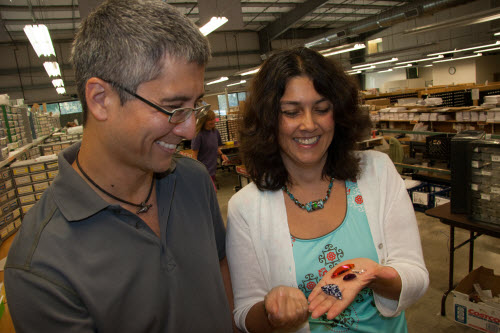
February is National Start a Business Month, so what better way to start things off than with expert advice from a successful entrepreneur? Devin Kimura, President and Co-Owner of Artbeads.com, shares some of the secrets to his success.
Math is important and pricing is personal

I’m fascinated by numbers. Math comes to me intuitively, and numbers float around in my head displacing normal thought. I think about modes and means, and understand that someone with their feet in the freezer and their head in an oven probably isn’t comfortable simply because a mathematical average suggests they’re warm. When watching TV with my kids and a commercial appears espousing the benefits of cabbage (“People that eat cabbage every day for breakfast have lower cholesterol”), I explain to them the difference between correlation and causation. Anyone that eats cabbage every day for breakfast is probably a health freak in all aspects of their life, and so their overall health is probably better than the bacon-and-egg types. Thus, cabbage consumption and cholesterol may show correlation but one is not necessarily the cause of another.
Where am I going with this, and what does this have to do with the business of making jewelry? My answer—nowhere in particular. But there is a point to this, and it is that math doesn’t live in a vacuum. It lives within context and its application varies depending on this context. I’ll give you an example: Pricing. I often hear of a “magic formula” for determining how one should price their jewelry. Can it be as simple as taking your materials cost, add in your labor cost and double that number to get at a price? Maybe. Maybe not. It depends on the context.

Allow me to elaborate by starting with a question — What motivates you to turn your jewelry-making passion into a business? While the obvious answer may be to make money, there is a lot of nuance to this. If you enjoy making jewelry because it is an expressive art that is a vital creative outlet essential to your well-being, you may want to price your jewelry more aggressively because your desire is to generate enough profit to buy more beads (blatant plug: hopefully from Artbeads) to meet your creative needs. In tandem with or independent of this desire comes the emotional need for recognition and validation. There is NOTHING wrong with this. Making a sale feels great, because a stranger has said, “You made something so beautiful that I would like to pay you money for the privilege of wearing this piece in front of my friends and colleagues.” This does wonders for self-esteem and is a therapy that has no physical side-effects but is not covered by insurance. If this is what motivates you, don’t price so high that nobody will place an order. What about doing a business selling jewelry to friends and coworkers? Perhaps you want to adjust your prices depending on the customer (half-price for the boss, double the price to the schmuck making elevator eyes at the young receptionist).
Devin, enough with your woo-woo touchy-feely blather! I want to make money selling my jewelry. Where do I set my prices? To quote my teenage son when asked how school was today: “I dunno.” And it’s true, I can’t tell you where to set prices. It really depends on so many factors. If you are selling in a massive handmade market like Etsy or even in a boutique market like ShopHandmade, there can be a lot of competition. If what you are making is similar to everything else out there, then you had better look at matching prices and forget the magic formula. Keep in mind, though, that consumers are smart, and that they look at the whole equation when assigning value to a product. This equation includes tangible items such as shipping costs, but also includes more nebulous facets that include the trust and reliability, speed of shipping, and return policies. These are costs that need to be considered when determining your prices. In order to successfully outprice the competition, you must be uniquely different in a way that is appealing to the consumer, and try to differentiate in a way that is difficult to copy (easier said than done).

Also consider how far you are willing to take the business. If you intend to maintain the business as a small side job, then you can probably keep your prices low because a home-based business, for example, doesn’t have a lot of overhead. But if you intend to grow, then you probably want to price in a way that fits into a business model that includes costs like rent, employees, and insurance even if you’re not there yet. If you can successfully sell at prices structured for a full-fledged business, you will see very good profitability while you are still small and will still be profitable enough to sustain your business as it grows. Why not keep my prices low at first and then raise them as costs increase? This is fine if you are always looking for new customers, but keep in mind that existing customers will feel alienated if all of a sudden you jack up your prices. The exception is when so-called exogenous factors come into play, such as fluctuations in the price of silver that raise costs across the board for all jewelry designers.
There are a million ways to look at prices, and I can go on and on talking about business and strategy (this happens to be my creative outlet!). If anything else, I hope that this blog entry has helped to open your mind to different ways of thinking about prices or at the very least gave you a break from your daily routine. I leave you with a funny but true story. A couple of years after college I moved to Japan, where I lived for six years and met my beautiful wife, Cynthia. While there, the Japanese government was trying to appease foreign trade bodies by encouraging the import of rice. The Japanese are very attached to home-grown rice. (By the way, my father’s family emigrated from Japan to the United States circa 1905.) One day, a store near where I lived got a huge shipment of foreign rice and it was priced at roughly half the price of Japanese rice. It didn’t sell, and this went on for a while. At some point, I assume the store needed to clear it out and so the price was dropped to 10 yen per bag. In other words, practically free! It still didn’t move. Huh? Then, the price was raised to something like 100 yen (about a half dollar at the time). And Whammo, it flew out the door. Pricing is a strange beast that takes many forms and can be your friend and foe at the same time, all the while being nothing more than a number.
– Devin
Want more tips on success? Visit our Seller’s Secrets page to find more expert advice and ways to get your business started.

I love the inspiration you leave behind with your arcticle. I run a beaded jewelry business out of my hime called B.E beads I would love to get alot of advice from you. Send stuff on my email. Thank you.
All these packages are efficient and effective in enhancing
the consumer’s ranking on search engines like Yahoo, MSN,
Google, and ASK as well as retaining superior amount of traffic.
This tactic is ‘borrowing’ others articles – syndication.
Google allows you to utilize as much as 10 pictures and I motivate you to utilize each
1 of them.